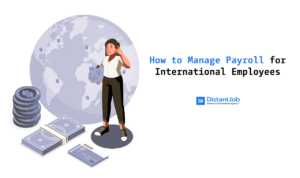Conflict is a natural part of any team dynamic, virtual or otherwise. It’s simply a reality when people collaborate, each bringing their own values, beliefs, and workplace habits into the mix. While resolving conflicts in a virtual team can seem daunting due to the lack of physical presence, it often presents fewer complexities than in traditional office settings. Understanding this can transform how we manage disagreements and foster a harmonious remote work environment.
In virtual teams, clear communication and structured conflict resolution strategies are not just beneficial; they’re essential for maintaining productivity and team morale.
Many managers believe that resolving conflicts in virtual teams is challenging due to the lack of face-to-face communication. They fear that this absence makes it easy for misunderstandings to escalate. They worry that striving to find a universally acceptable solution might be an insurmountable task.
However, while these challenges are real, effective solutions do exist. In this article, I’ll explain my perspective and share practical tips that have successfully mitigated conflicts in virtual settings, proving that with the right strategies, virtual team conflict resolution is not only possible but can also strengthen team cohesion.
Virtual Teams Can Fix Problems Instantly
I know what you’re thinking – and no, I am not a mind reader!
“If there is a problem, I can schedule a meeting to discuss it. We’re in the same building—easy!”
Hold your horses! Scheduling a meeting can be a real struggle. You must consider the availability and workload of your employees. As a result, you will keep putting it off, and the subject of conflict festers, and eventually, over the course of a few days, it snowballs into something that is straight out of a disaster movie. There could be name-calling, extreme gossiping, cold vibes, passive-aggressive treatment, and all the other toxic behaviors you can think of. Before you know it, the “trickle-down” effect begins, and this conflict that was between two people has somehow become a ten-person war.
Those extra trips to the water cooler and those extra meetings in the conference room mean less work and more drama. Drama is interesting in movies but most definitely unwelcome in a professional setting. It is conducive to an unproductive environment that has a direct impact on your business.
In complete contrast, a virtual setting allows people to be more confident. They are more able to stand up for themselves and express their points. Psychologically speaking, the fear of judgment is negligible. Factually, everyone is miles apart from one another. The inhibition to face someone in flesh and blood does not exist, which in turn boosts confidence to express oneself better virtually. This also lessens the probability of the “trickle down” effect. There is no possibility of extra water cooler trips and excessive gossiping.
Don’t believe it? Let’s check in with the science of human psychology, shall we? The I-can-say-whatever-I-want-online phenomenon is known as The Online Disinhibition Effect in psychology. This fancy term means that people don’t obey social restrictions when online.
From the remote team manager’s POV, it means your employees will share their concerns more freely. This will make solving conflicts much easier. It’s time to take a look at some concrete steps that will assist you in clearing up the tension.
Step 1. – What’s The Problem, Though?
First things first. Understand what the problem is. Is it task-related? Is it related to interpersonal skills? The nature of the problem will determine your approach towards conflict resolution. Get to the core of the issue. It is always important to ask and not assume. If you see some tension brewing between your designer and developer, ask both of them separately about what the issue is. Jumping to conclusions is not the sport you want to indulge in lest you want your business to get fractured. Knowing all the details will be very useful, especially during the second step – the reason.
Step 2. – Why Exactly Did That Happen?
Getting on a video chat with your designer and web developer and asking them to just “get along” is not the solution. You have to find the root, get to it, and chop it off in order to be successful with conflict resolution in virtual teams.
It could be anything from mere miscommunication to cultural differences.
As a manager, your task is to investigate and uncover all the reasons for this conflict. Otherwise, you’ll be at a dead end that halts your efforts.
Step 3. – Listen To Both Sides
Work with each “side” at a time. If you make it a group discussion, it could turn into a fight. Annoyed people use “selective listening” to just hear the part where they are “right.” Everything else will be ignored. Don’t expect empathy from either side for the other. It is natural for them to be irate. That is why the conflict exists in the first place.
Gather as much information as you can until you can put yourself in their shoes.
Step 4. Eliminate Chinese Whispers
The Shannon-Weaver Model of Communication puts people in the role of transmitter and receiver, understanding that what you say might not be understood in the same way by the person you’re talking to because we all filter things through our own experience and understanding. What this means is that communication is clearest when you know the person you’re talking to, and can target the message to them directly.
Where this gets complicated, is if you get into a Chinese-whispers situation. Bob comes to talk to you and tells you that Mary has a problem with Mike. You craft a lovely and supportive message designed to bring Mary and Mike together, but Bob delivers it in his own rather blunt fashion. Hijinx ensue. In other words, deliver your message yourself whenever possible.
Step 5. – The game is on
If we were in a Sherlock movie, “the game would be on,” Watson.
As Holmes would say, we have the problem, we know the reasons, so it’s time to get down to action.
Here, my tips get a little vague. Sorry! There are a hundred thousand possible problems and solutions. Discussing them one by one in an article would take a couple of lifetimes. Nonetheless, you have all the resources, tools, and information. Knowing this, making the right decision won’t ask for sleepless nights and all your energy.
You’ll have to play the “good cop” here. You have a huge advantage if you binge-watch any series related to investigations and interrogations—just saying! Be as diplomatic as possible. You don’t want either party to be disappointed with your judgment. This is not a courtroom, and nobody is getting convicted.
Try to create a win-win situation by appealing to the team spirit if the solution you offer is in favor of one side over the other. Whenever possible, try to come up with a compromise by taking into account the needs of everyone involved.
Worst case scenario, you can always change the team and assign different partners. Bear in mind that if you’ve tried a couple of times and the problem persists, you need to change their teams. Sometimes, that really is the best solution for conflict resolution in virtual teams.
How To Minimize Conflict in Virtual Teams?
Note that I didn’t say “avoid” because, let’s admit, it’s hardly possible.
Leaders such as Joel Peterson, chairman of JetBlue Airways, claim healthy and managed conflict can generate new ideas. This kind of conflict can also result in better workflow and increased productivity.
The moral of the story is that you shouldn’t let conflict scare you. Learn to embrace it.
Focus on reducing small and unnecessary conflicts. Some examples are misinterpreted messages, tasks or privacy issues. Here is how you do it:
- Create an online discussion platform. All team members should participate. The team must have access to all projects, dates, shared files, and updates related to their work. This way, you can guarantee that everyone is on the same page. But for the sake of privacy, you can have subcategories. Set up channels and items that are accessible to everyone or only to a particular group.
- Assign a mediator, someone who people can turn to when conflict arises. Rule of thumb: the sooner you solve it, the better. Letting the issue sit until you have the time to handle it is wrong. It could be the project manager, HR or a position created especially for that effect. Have someone dedicated to problem-solving who is ready to tackle them as they arise.
- Online chats are crucial. And you need all kinds -, audio, video, and text. Virtual teams are susceptible to a lack of communication. The reasons are plentiful: time zone differences, language, not feeling the tone, culture – the list goes on. Video chat comes to the rescue. Face-to-face communication allows your employees to understand each other better.
- Have some quality time with your virtual team. As we all know, you can do that virtually, too. If the team members bond, they’ll be able to solve their issues among themselves, and you won’t have to interfere.
- Be Clear When You Hire Virtual Employee: Predictably, the way your team operates ultimately comes down to your recruitment decisions and processes. If you hire people who are great at their jobs and experienced in working remotely, you’re less likely to experience these kinds of conflicts.
You don’t have to be an expert to initiate conflict resolution in virtual teams. Keep an objective mindset. Take your time to evaluate the situation. When you’re ready, use all the leverage you can get to come up with a suitable solution.
Of course, conflicts will always exist in personal and professional life, in a virtual or on-site work environment. What really matters is how you approach possible solutions to the problem or how you try to avoid the root of the problem itself—for example, hiring the right candidates. Let us help you find the best one to grow your virtual team!




